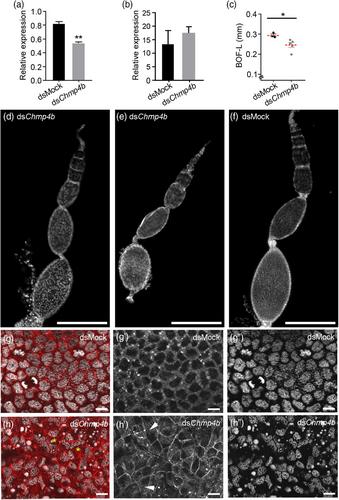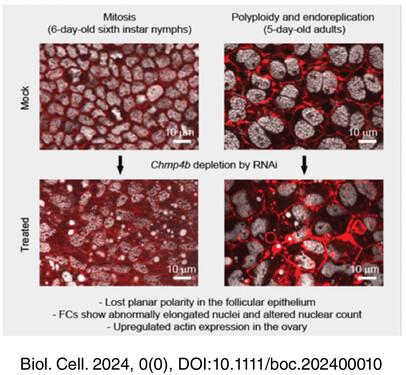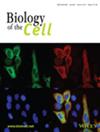The Endosomal Sorting Complex Required for Transport (ESCRT) is a highly conserved cellular machinery essential for many cellular functions, including transmembrane protein sorting, endosomal trafficking, and membrane scission. CHMP4B is a key component of ESCRT-III subcomplex and has been thoroughly studied in the meroistic ovaries of Drosophila melanogaster showing its relevance in maintaining this reproductive organ during the life of the fly. However, the role of the CHMP4B in the most basal panoistic ovaries remains elusive.
Using RNAi, we examined the function of CHMP4B in the ovary of Blattella germanica in two different physiological stages: in last instar nymphs, with proliferative follicular cells, and in vitellogenic adults when follicular cells enter in polyploidy and endoreplication. In Chmp4b-depleted specimens, the actin fibers change their distribution, appearing accumulated in the basal pole of the follicular cells, resulting in an excess of actin bundles that surround the basal ovarian follicle and modifying their shape. Depletion of Chmp4b also determines an actin accumulation in follicular cell membranes, resulting in different cell morphologies and sizes. In the end, these changes disrupt the opening of intercellular spaces between the follicular cells (patency) impeding the incorporation of yolk proteins to the growing oocyte and resulting in female sterility. In addition, the nuclei of follicular cells appeared unusually elongated, suggesting an incomplete karyokinesis.
These results proved CHMP4B essential in preserving the proper expression of cytoskeleton proteins vital for basal ovarian follicle growth and maturation and for yolk protein incorporation. Moreover, the correct distribution of actin fibers in the basal ovarian follicle emerged as a critical factor for the successful completion of ovulation and oviposition.
The overall results, obtained in two different proliferative stages, suggest that the requirement of CHMP4B in B. germanica follicular epithelium is not related to the proliferative stage of the tissue.




